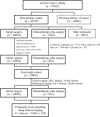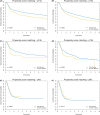Prognostic impact of bridge or neoadjuvant induction chemotherapy in patients with resected oral cavity cancer: A nationwide cohort study
- PMID: 39101462
- PMCID: PMC11299076
- DOI: 10.1002/cam4.70061
Prognostic impact of bridge or neoadjuvant induction chemotherapy in patients with resected oral cavity cancer: A nationwide cohort study
Abstract
Background: While surgery remains the primary treatment for oral squamous cell carcinoma (OCSCC), induction chemotherapy (IC) can be used as a bridging or neoadjuvant therapy. This nationwide study in Taiwan examines the survival outcomes of OCSCC patients who received IC before surgery.
Methods: We analyzed data from 29,891 patients with OCSCC. Of these, 29,058 initially underwent surgery (OP group), whereas 833 received IC before surgery (IC + OP group). A propensity score (PS)-matched analysis (4, 1 ratio, 3260 vs. 815 patients) was performed considering tumor subsite, sex, age, Charlson comorbidity index, clinical T1-T4b tumors, clinical N0-3 disease, and clinical stage I-IV.
Results: In the PS-matched cohort, the 5-year disease-specific survival (DSS) and overall survival (OS) rates were 65% and 57%, respectively. When comparing the OP and IC + OP groups, the 5-year DSS rates were 66% and 62%, respectively (p = 0.1162). Additionally, the 5-year OS rates were 57% and 56%, respectively (p = 0.9917). No significant intergroup differences in survival were observed for specific subgroups with cT4a tumors, cT4b tumors, cN3 disease, pT4b tumors, and pN3 disease. However, for patients with pT4a tumors, the OP group demonstrated superior 5-year outcomes compared to the IC + OP group, with a DSS of 62% versus 52% (p = 0.0006) and an OS of 53% versus 44% (p = 0.0060). Notably, patients with cT2-3, cN1, and c-Stage II disease in the IC + OP group were significantly more likely to achieve pT0-1 status (p < 0.05).
Conclusions: Following PS matching, the IC + OP group generally exhibited similar prognosis to the OP group. However, for pT4a tumors, the OP group showed superior 5-year outcomes. While IC may not universally improve survival, it could be advantageous for patients who respond positively to the treatment.
Keywords: cancer registry; clinical outcomes; induction chemotherapy; oral cavity squamous cell carcinoma.
© 2024 The Author(s). Cancer Medicine published by John Wiley & Sons Ltd.
Conflict of interest statement
The authors declare that there are no conflicts of interest that could potentially influence the presentation or interpretation of the research findings in this study.
Figures



Similar articles
-
Clinical outcomes of patients with pT4a and pT4b oral cavity squamous cell carcinoma who had undergone surgery: Results from a Taiwanese registry-based, nationwide cohort study.Oral Oncol. 2022 Mar;126:105750. doi: 10.1016/j.oraloncology.2022.105750. Epub 2022 Feb 2. Oral Oncol. 2022. PMID: 35123256
-
Comparing the clinical outcomes of initial surgery and primary definitive radiotherapy with a dosage of 6600 cGy or higher in cT1-2N0M0 oral cavity squamous cell carcinoma: A nationwide cohort study.Cancer Med. 2024 May;13(10):e7127. doi: 10.1002/cam4.7127. Cancer Med. 2024. PMID: 38770540 Free PMC article.
-
Clinical Outcomes of Taiwanese Patients with cT4 Oral Cavity Squamous Cell Carcinoma: Toward the Identification of the Optimal Initial Treatment Approach for cT4b Patients.Ann Surg Oncol. 2017 Mar;24(3):785-793. doi: 10.1245/s10434-016-5629-x. Epub 2016 Nov 28. Ann Surg Oncol. 2017. PMID: 27896513
-
Neoadjuvant chemoradiation therapy is beneficial for clinical stage T2 N0 esophageal cancer patients due to inaccurate preoperative staging.Ann Thorac Surg. 2012 Feb;93(2):429-35; discussion 436-7. doi: 10.1016/j.athoracsur.2011.10.061. Ann Thorac Surg. 2012. PMID: 22269708 Free PMC article. Review.
-
Defining response-adapted surgery after neoadjuvant therapy in oral cavity cancer.Oral Oncol. 2025 Jun;165:107349. doi: 10.1016/j.oraloncology.2025.107349. Epub 2025 May 8. Oral Oncol. 2025. PMID: 40339433 Review.
References
-
- National Comprehensive Cancer Network Clinical Practice Guidelines in Oncology, Head and Neck Cancers, Version 4.2024. Accessed May 20, 2024. http://www.nccn.org/
-
- Lin CY, Fan KH, Lee LY, et al. Precision adjuvant therapy based on detailed pathological risk factors for resected oral cavity squamous cell carcinoma: long term outcome comparison of CGMH and NCCN guidelines. Int J Radiat Oncol Biol Phys. 2020;106(5):916‐925. doi:10.1016/j.ijrobp.2019.08.058 - DOI - PubMed
-
- Rudresha AH, Chaudhuri T, Lakshmaiah KC, et al. Induction chemotherapy in TechnicallyUnresectable locally advanced T4a Oral cavity squamous cell cancers: experience from a regional cancer Center of South India. Indian J Med Paediatr Oncol. 2017;38(4):490‐494. doi:10.4103/ijmpo.ijmpo_185_16 - DOI - PMC - PubMed
MeSH terms
Grants and funding
LinkOut - more resources
Full Text Sources
Medical
Miscellaneous

